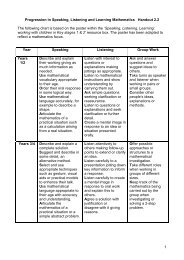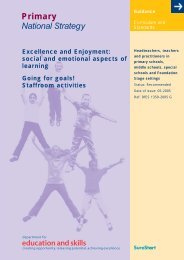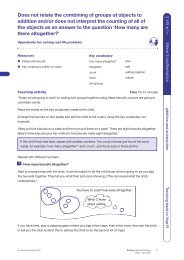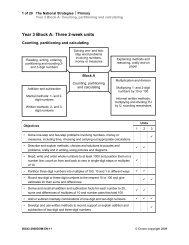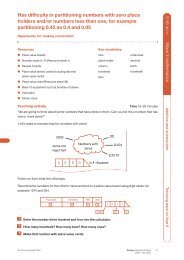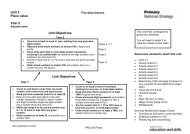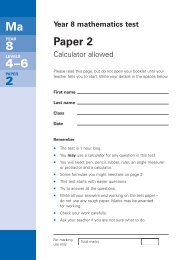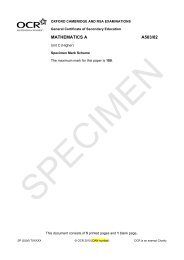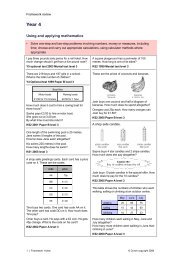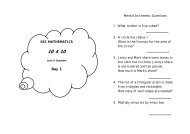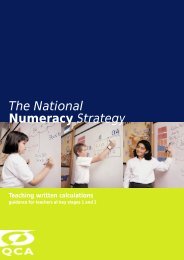Masterclass: Take Action Issue 4 - Staffordshire Learning Net
Masterclass: Take Action Issue 4 - Staffordshire Learning Net
Masterclass: Take Action Issue 4 - Staffordshire Learning Net
You also want an ePaper? Increase the reach of your titles
YUMPU automatically turns print PDFs into web optimized ePapers that Google loves.
<strong>Issue</strong> 4<br />
Spring 2012<br />
MaSTerclass<br />
<strong>Take</strong> action!<br />
Early<br />
counting<br />
Case studies:<br />
Mathematics<br />
Specialist Teacher<br />
programme<br />
gets results<br />
Dot to dot:<br />
Developing the skill<br />
of subitising<br />
Join in:<br />
Test your class with<br />
our puzzles page<br />
Maths teachers move<br />
from excellent to outstanding
<strong>Issue</strong> 4, Spring 2012<br />
<strong>Masterclass</strong> – <strong>Take</strong> action<br />
Welcome<br />
As I reflect on the past few years of the MaST<br />
programme, I can’t help but be impressed and<br />
inspired by teachers who have participated. Not<br />
only have they seen an improvement in their<br />
own mathematics teaching, but there is clear<br />
demonstration that their work is making a big<br />
impact across the school. It is clear that these<br />
teachers are bringing their vision and leadership<br />
skills together to improve schools.<br />
So what makes this so successful There is<br />
no doubt in our minds (or in the minds of head<br />
teachers who have seen these benefits), that<br />
commitment from the head teacher, support for<br />
MaSTs attending meetings during school time,<br />
and support and resources to undertake inschool<br />
activities linked to a school improvement<br />
plan, are key factors. Despite changes<br />
in funding, registration to the programme<br />
continues to rise. The fact that head teachers<br />
are willing to pay this and support their teachers<br />
on the programme (even allowing them to be<br />
away from their classrooms for short periods of<br />
time), shows their very real commitment to the<br />
programme, and their conviction that there will<br />
be a good return on their investment. Each and<br />
every one of those head teachers who has a<br />
member of staff signed up to MaST is giving a<br />
massive vote of confidence to both the MaST<br />
team here at Edge Hill University and to our<br />
local authority partners.<br />
We are now actively recruiting for Cohort 4.<br />
Once again, schools will have the opportunity to<br />
invest in outstanding professional development<br />
which is linked directly to school improvement<br />
plans and which has been demonstrated<br />
to make a huge difference to teaching and<br />
learning, leadership development and<br />
children’s achievement.<br />
If this is the first time you have seen a<br />
MaSTerclass magazine, I extend a very warm<br />
welcome. In this issue we focus on early<br />
counting, with views from two experts in the<br />
field and case studies of MaST in action. Do<br />
get in touch with us if you have comments or<br />
questions. You are a vital part of the three way<br />
partnership – Edge Hill, local authorities and<br />
schools – that is making MaST so successful.<br />
One last word. You may have noticed that<br />
we are using the NCETM logo, indicating<br />
that we, the Edge Hill MaST team, have met<br />
their standard for Continuing Professional<br />
Development provision. This is another<br />
valuable endorsement of the MaST<br />
programme at Edge Hill.<br />
Dr Mary McAteer<br />
MaST Project Director<br />
Edge Hill University<br />
A unique<br />
view of maths<br />
improvement<br />
Senior lecturer Sue Bailey has a unique view of the MaST programme. She<br />
is seconded to the programme at Edge Hill for three days a week, but is still<br />
also a primary maths consultant for Lancashire, which means she gets to see<br />
things from both sides of the fence.<br />
Sue takes an active role in advising teachers currently on the MaST programme, in<br />
supporting them with their assignments, developing teaching material and helping to<br />
organise the Saturday lectures and workshops.<br />
She says: “Having both roles is interesting and gives me a complete picture of the<br />
MaST programme and the impact it is having on mathematics teaching and practice.<br />
I find my involvement in the local meetings particularly useful. I’m there with my<br />
Lancashire hat on; but can take the teachers’ ideas and feed them back into the<br />
central MaST team, and I can see how my local teachers are building up their<br />
subject knowledge.<br />
The two things complement each other. The local meetings are all about cohort<br />
members sharing ideas and knowledge, but then at the workshops and study<br />
days I see them unpicking the deeper theories and rethinking aspects of their own<br />
mathematics teaching.<br />
It is really good, getting to know the students in my local group and seeing them<br />
develop. One particularly encouraging thing is that one group now coming to the end<br />
of its formal local network meetings plans to carry on. The teachers are hoping to<br />
keep meeting up – and that must mean that they find the whole process valuable.”<br />
Having two distinct roles means spinning lots of plates sometimes, but Sue says she<br />
enjoys the constant challenge.<br />
“I really like the student support aspect on MaST, answering questions and making<br />
the whole process clearer for them. I get a lot out of the one-to-one email support<br />
too, and I also enjoy the visiting lecturers and workshops. Getting to know individual<br />
teachers on the programme is really great.<br />
Obviously, there are cost implications when it comes to joining MaST, but I think<br />
most schools see it as an investment in the whole team, not just one member<br />
of staff.<br />
From the teachers’ point of view, it does call for a high level of commitment – there is<br />
work to be done outside of school hours, and it can be challenging – but feedback to<br />
MaST and the positive impact it can have in the classroom has been really good.”<br />
Sue Bailey<br />
Calling all new recruits<br />
to MaST<br />
We are now recruiting for a new MaST cohort, so why not sign up for a unique<br />
programme of professional development leading to lasting school improvement<br />
It’s a win-win. One teacher<br />
takes part in MaST, but<br />
every member of a school’s<br />
teaching staff can benefit<br />
from the programme because<br />
as they grow into their role,<br />
a Mathematic Specialist<br />
Teacher works closely with<br />
colleagues to identify needs<br />
and support professional<br />
development opportunities<br />
in mathematics.<br />
Jan Jackson<br />
Schools taking part in MaST<br />
get a new tool for lasting<br />
classroom improvement as<br />
well as a positive impact on the quality of teaching and learning<br />
in school and a reinvigorated attitude towards maths for teachers,<br />
children and parents.<br />
Numbers are increasing with each Edge Hill MaST cohort, as<br />
head teachers begin to see the wider benefits of the programme,<br />
and feedback clearly shows that MaST can lead to improvements<br />
in pupil attainment .<br />
Teachers who successfully complete the MaST programme<br />
are awarded a Postgraduate Certificate in Specialist Primary<br />
Mathematics (worth 60 credits at Masters Level) and Mathematics<br />
Specialist Teacher status.<br />
Case study<br />
MaST has transformed<br />
my career<br />
The MaST programme not only<br />
boosted Rachel Burns’ confidence –<br />
it also transformed her teaching day.<br />
Rachel is now teaching mathematics full time at Moor Green<br />
Primary School in Birmingham; something she says could<br />
never have happened without MaST.<br />
She says: “I have got my dream job. I have gone from being a<br />
classic maths phobic to a fully fledged maths geek – and proud<br />
of it. Seriously, the programme made me much more aware of<br />
the massive range of resources on offer and put me in touch<br />
with a group of people who have taught me so much. The<br />
interaction with other teachers on the programme was really<br />
important and helped give me good ideas.<br />
I have been able to transfer the learning straight into the<br />
classroom. I have now taught maths to every year group,<br />
Sounds like a great opportunity It is – but it also calls for<br />
commitment, with some events and personal study at weekends<br />
and ‘out of hours’.<br />
Jan Jackson, MaST Project Manager says: “MaST is evolving<br />
from an excellent professional development and school<br />
improvement programme into an outstanding one.<br />
When I speak to teachers taking part it is quite clear that their<br />
view of mathematics changes – and so does the methods they<br />
use. MaST gives them the benefit of expert opinion and new<br />
thinking, and an opportunity to hear from fellow teachers in<br />
other settings. This sharing of knowledge is fundamental to<br />
the programme’s success.<br />
MaST isn’t something you devote the occasional hour to; it tends<br />
to become all consuming, which is great, because that can only<br />
be down to the enthusiasm and vigour of the teachers involved.”<br />
Remember:<br />
This is your last chance to get partial funding from DfE<br />
(they pay half of the first year).<br />
It’s great value for money – the whole school benefits, and<br />
MaST provides 12 half days of Local Consultant time, plus<br />
keynote speakers who are leaders in the field. To find out<br />
more call 01695 650774 or email mast@edgehill.ac.uk.<br />
even Reception, and am also working with small groups of<br />
gifted and talented pupils.<br />
I have also contributed to a maths training day for NQTs run<br />
by the local authority maths adviser. I would not have had<br />
the confidence to do something like that before. Maths was<br />
a subject I did not enjoy at school and I would never have<br />
believed I could end up doing this.<br />
MaST has given me a deeper subject knowledge and<br />
pedagogy and real enthusiasm for the subject which has<br />
been transferred to the children. We run a maths club at<br />
school, and the children are so keen to learn.<br />
I think the programme was excellent; probably the best<br />
professional development I have come across. I was one<br />
of the first to take part and it’s no exaggeration to say<br />
that MaST has transformed my outlook, my teaching<br />
and my career.”<br />
2<br />
jacksonj@edgehill.ac.uk<br />
jacksonj@edgehill.ac.uk<br />
3
<strong>Issue</strong> 4, Spring 2012<br />
<strong>Masterclass</strong> – <strong>Take</strong> action<br />
Look and learn:<br />
join the<br />
subitising set<br />
When you play a board game using dice you are probably subitising. It’s the<br />
same with dominoes. As any mathematics teacher will know, subitising is the<br />
ability to recognise the number of objects (dots, in the example of dice) without<br />
actually counting them.<br />
Ian Sugarman<br />
This method of knowing a number simply by looking at a grouping<br />
is something most adults take for granted, but it is a skill that is<br />
developed at a very young age.<br />
Pre-school children can quickly learn to recognise small groups<br />
of dots, or lines (or just about any object) without having to count<br />
them individually, and their ability to do this is a fundamental<br />
building block in the teaching of number to Reception and Year<br />
One pupils.<br />
Primary Mathematics Consultant Ian Sugarman is a visiting<br />
lecturer on the Edge Hill University MaST programme and has<br />
focused on this subitising skill, helping teachers to see the<br />
benefits of actively developing it in their pupils and showing<br />
how it can lead to a better understanding of number and early<br />
strategies of calculating.<br />
Ian explains: “Often in the teaching of four and five year olds the<br />
emphasis is on mechanically counting small quantities of things.<br />
But children can ‘see’ these numbers as a group from an early<br />
age, and if a teacher can draw a child’s attention to his or her<br />
ability to visualise numbers in this way, it helps give the child a<br />
deeper understanding of how numbers relate to each other and<br />
it can have a big impact when children move on to calculating<br />
numbers mentally.”<br />
Benefit<br />
“By encouraging subitising a teacher is getting a child to use<br />
both sides of the brain: it is not just about memory or mechanical<br />
counting; it is about recognising shapes and patterns, which is a<br />
different skill and of huge benefit in early number work.<br />
Often children can see groupings very quickly, and this is<br />
something Ian demonstrates by quickly flashing an image onto a<br />
screen and asking children to reproduce it. Some children may<br />
need to look up two or three times, but most can hold the image<br />
in their mind and reproduce it perfectly after seeing it fleetingly<br />
for just a couple of seconds.<br />
He explains: “You put a simple line drawing on the screen and<br />
ask the children to copy it using a pile of sticks on a table in front<br />
of them. If there is a pattern or a symmetrical element to the shape,<br />
children can hold onto that image and reproduce it easily. Crucially,<br />
they know how many sticks are needed to recreate the shape.<br />
I encourage teachers on MaST to introduce this sort of activity into<br />
the classroom. It is fun of course, but it develops and enhances<br />
this subitising skill, which is a way of getting children to slow<br />
down and explore numbers, examining them in a way that simple<br />
mechanical counting does not.”<br />
Skills<br />
The ability to see groups instead of counting separate items leads<br />
to other important skills when children move onto more complex<br />
number work. For example, if a child can see a group of sticks,<br />
and identify how many triangles could be made from those sticks,<br />
they can also see how many ‘threes’ they need.<br />
Ian says: “There are lots of ways to engage children. It used to<br />
be a case of using flash cards, which were then replaced by a<br />
series of Powerpoint slides. But now I’ve been able to offer this<br />
as a ready-made software activity. It’s the sort of activity that<br />
should be done little and often in the classroom because it is not<br />
a maths technique that can be compartmentalised – it flows into<br />
many aspects of number work.<br />
I had one teacher in a previous lecture who told me that these<br />
ideas on subitising had completely transformed the way she and<br />
her colleagues approached counting with Early Years pupils.<br />
At her setting they had reorganised and given a fresh priority to<br />
this skill, and I don’t think that’s unusual.<br />
Adults can forget that their ability to ‘see’ groups of things without<br />
counting is a skill that underpins their understanding. Getting<br />
back to basics and building these activities into lessons for the<br />
youngest learners can have a big impact.”<br />
More about Ian…<br />
Ian Sugarman has many years experience as a Primary<br />
practitioner, advisory teacher in Shropshire and trainer of<br />
Primary teachers at Manchester Metropolitan University.<br />
He has produced an extensive range of mathematics<br />
curriculum materials, served on QCA committees producing<br />
guidance on the teaching of mental and written calculation<br />
strategies and the writing and reviewing of SATs.<br />
He is a well established author of journal articles and<br />
curriculum booklets and has served on UK Government<br />
committees for the production of national assessment<br />
packs and guidance. With 25 years experience as a<br />
training provider for Primary teachers he is still very much<br />
classroom-based, and since retiring from MMU has been<br />
working with both gifted and talented and under-attaining<br />
pupils at several schools.<br />
He is co-author of Numbergym software, designed for<br />
non-specialist teachers and parents from Foundation<br />
stage to GCSE.<br />
For more information and ideas see his website at<br />
www.sugarmaths.net<br />
Case study<br />
Putting Ian’s<br />
ideas into<br />
action<br />
Ian Sugarman’s lecture on subitising<br />
led to a change of practice in the<br />
Reception class at Aspull Church<br />
Primary School near Wigan.<br />
Teacher Alison Moore was a member of the first MaST<br />
cohort and says that introducing some of Ian’s techniques<br />
for number recognition has made a big difference to pupils.<br />
She says: “I had gone from being a Year 6 teacher to<br />
Reception, and of course the younger children had very<br />
different needs when it came to learning maths.<br />
After hearing Ian’s lecture I decided to try out some of the<br />
ideas and the children did really well as a result. We used<br />
dice games and looked at patterns and somehow it just<br />
‘clicked’ with them – it made a tangible difference.”<br />
Training<br />
“I have been able to incorporate other elements of the<br />
MaST programme into our teaching, and we are just starting<br />
to include some things into staff training too, which means<br />
my colleagues also get the benefit of the learning.<br />
MaST enables you to look more closely at how young<br />
children learn maths and helps you to deal with some of<br />
the most common problems they can face.<br />
The local meetings on the programme were very useful<br />
as a way of sharing ideas, and getting together with other<br />
teachers helps you see that the same ‘problems’ in teaching<br />
and learning maths occur at many other schools.<br />
My colleagues on the cohort were a very important source<br />
of support, and even though I finished the programme at<br />
Christmas, I still keep in touch with them.<br />
Being part of the first MaST cohort meant that I wasn’t<br />
exactly sure what to expect. Although it’s true that MaST<br />
demands considerable personal commitment and<br />
can be time consuming when you already have a<br />
full time job, I would recommend it to others.”<br />
4<br />
jacksonj@edgehill.ac.uk<br />
jacksonj@edgehill.ac.uk<br />
5
<strong>Issue</strong> 4, Spring 2012<br />
<strong>Masterclass</strong> – <strong>Take</strong> action<br />
One, two, three steps<br />
to success in<br />
early counting<br />
Early number expert Professor Effie MacLellan, Research Professor of Education<br />
at the University of Strathclyde, is a visiting lecturer on the MaST programme. A<br />
former primary school teacher, she advocates the use of simple classroom-based<br />
counting techniques to help young children understand both the concept and its<br />
importance. Here she answers some questions frequently asked by teachers.<br />
She says: “What does it mean to say<br />
that someone can count For adults,<br />
counting is a seemingly straightforward<br />
activity: they notice the set of items to<br />
be counted, assign a number name to<br />
each item and recognise that the last<br />
number name used defines the total<br />
number of items in the set.<br />
That adults are skilled in counting<br />
is not surprising – most of us have<br />
Effie MacLellan been practising since the age of<br />
two. Of course two year olds cannot<br />
count with the same level of skill as<br />
adults, but research shows that the rudiments of counting can be<br />
observed in many two year olds. Counting is both a very complex<br />
process and a very important process.”<br />
How long does it take for a child to<br />
learn the number names<br />
How long is a piece of string Most children will have learned the<br />
sequence up to 100 by about six or seven years of age. Typically,<br />
two to three year olds can reliably produce the string ‘one, two,<br />
three’, though after ‘three’ may become confused. The hardest<br />
part of learning the number names is learning the sequence from<br />
‘one’ to ‘thirteen’, because all the names are so very different from<br />
each other. By the time the child has learned the number name<br />
sequence to ‘twenty’, they may have spotted part of the repeating<br />
one to nine pattern: four and fourteen, six and sixteen and so<br />
on. Once children have mastered the number name sequence to<br />
twenty and have grasped the repeating pattern, all that is left is for<br />
them to learn the decade names: thirty, forty, and so on. It takes<br />
most young children four or five years to learn the number name<br />
sequence up to one hundred.<br />
Can children count when they know<br />
the number names<br />
Categorically no. Counting involves much more than the rehearsal<br />
of strings of number names. Counting involves three procedures.<br />
First, there has to be a pairing of each item with a number name.<br />
Someone counting has to mentally ‘move’ (and possibly physically<br />
move) each item from a to-be-counted category to an alreadycounted<br />
category and, at the same time, must assign a different<br />
number name to each item. This pairing is open to error. One is<br />
when the person counting either counts an item twice or misses<br />
one out. Another error is when there is a mistake made in using<br />
the number names (perhaps using the same number name twice).<br />
A third is when the person counting fails to ‘move’ and name the<br />
items in a synchronised fashion: for example the number naming<br />
may be in advance of the ‘moving’ of items; the naming may<br />
continue after the ‘moving’ is complete; or during the procedure<br />
there may be a failure to maintain one-to-one correspondence so<br />
that although the procedure begins and ends in synchrony, there<br />
has been some confusion in between.<br />
Second, while assigning a number name once, and only once, to<br />
each item in the array is important, it is not enough. Additionally,<br />
the sequence of number names generated must be reliably<br />
produced from one count to another. We have to learn a stable<br />
list of counting words and use this list consistently.<br />
The third procedure is the recognition that the final number name<br />
used has a special significance. This final number name defines<br />
the total number of items which were counted. This is later in<br />
developing than the first two procedures and is dependent upon<br />
the first two. A child may be able to pair number names and<br />
items-to-be-counted and may assign the number names in a<br />
fixed order but may not further know that the last number name<br />
assigned represents the numerosity of the items.<br />
I was taught that before children can<br />
really learn to count, they must be able<br />
to sort objects into groups<br />
Yes, but this is only a bit of the story. Actually children will count<br />
elephants, bananas and toys or girls and lollipops and refer<br />
to such collections as “things”. This means that the ‘sorting’<br />
activities, often used in early education, are not as important<br />
to understanding counting as was once thought.<br />
So if ‘sorting’ activities are not essential,<br />
what about ‘matching’ Don’t children<br />
need one-to-one correspondence before<br />
they can count<br />
Yes, children do need one-to-one correspondence in order to<br />
count, but what is questionable is whether children need to<br />
engage in the ‘matching’ activities of assigning straws to cups of<br />
juice or eggs to egg cups. If the child can pair a number name with<br />
an item and continue pairing a different number name to each new<br />
item in the set, the child already has one-to-one correspondence.<br />
Remember that one-to-one correspondence is an abstract notion;<br />
it is not something we can see.<br />
Is counting important<br />
Yes. Counting is a pre-requisite for many other mathematical<br />
activities such as telling the time and multiplying. And counting<br />
is the means by which young children penetrate the concepts<br />
of addition and subtraction. When a set of items has been<br />
transformed either through some items being<br />
added or removed, the only strategy which the<br />
young child has for defining the outcome of the<br />
transformation is counting. When children<br />
start school, they may have informal knowledge<br />
of addition and subtraction.<br />
Case study<br />
Looking at practice<br />
in the Pacific<br />
Big changes could be on the cards<br />
for Katie Hebden, a Year 3 teacher<br />
from Millfields CE Primary on the<br />
Wirral. She is hoping that involvement<br />
in MaST will help her secure a<br />
teaching role in New Zealand.<br />
She says: “I think the programme is really good at developing<br />
your understanding of the child as a mathematical learner.<br />
You would not get that in everyday teaching.<br />
I teach Year 3, but since MaST have been doing some<br />
intervention work with small groups and also some one-to-one,<br />
helping children overcome their maths misconceptions.<br />
The programme was very useful. I now know where to<br />
find good resources and the pedagogy was excellent.<br />
It was certainly more than just an investment in me;<br />
What can I do to promote the young<br />
child’s counting<br />
Good readers are the people who do a lot of reading; young<br />
children who are good at counting tend to have done lots of<br />
counting. Many children count when there is nothing in the<br />
immediate environment which demands it: they get intrinsic<br />
satisfaction from counting.<br />
• For children who have not developed the conventional list of<br />
number words, there is nothing to be lost by some rote counting:<br />
rehearsing the sequence of number names, perhaps to ten.<br />
• The pairing of a number name with an item can be better<br />
managed by children if they point to each item in the set.<br />
Pointing, while saying the number names, is a cue to the<br />
child that each item is counted once and only once.<br />
• Be ready to show the children the observable behaviour you<br />
wish them to demonstrate. If you want the children to touch<br />
the items as they are being counted, show them clearly what<br />
you want. Check and correct, with further demonstration, those<br />
who are having problems in synchronising the touching and<br />
the naming. Similarly, be ready to make explicit what children<br />
seem to know, but do not articulate clearly. For example, having<br />
executed a count correctly, the children can be reminded that<br />
the last number name used tells how many are in the set.<br />
• Don’t worry if children use their fingers to make sense of<br />
counting more easily. Traditionally there has been a fear that<br />
children would become over dependent by a reliance on<br />
fingers for counting but there is no evidence to suggest that<br />
by using their fingers to support their counting, children are<br />
handicapping themselves, either short or long term.<br />
it is about sharing the ideas and activities with other teachers<br />
and TAs in my school.<br />
Whilst researching for my initial assignment on language<br />
within mathematics I was interested in how this was widely<br />
developed and focused on in the Pacific region, especially<br />
New Zealand education. It appeared that the children<br />
progressed a lot quicker at an earlier stage with only the<br />
key concepts being taught.<br />
When it was time to do my second assignment I looked again<br />
at their Maths Curriculum and really liked the emphasis they<br />
gave to their teachers’ pedagogy and wanted to be part of it.<br />
So at Easter I am travelling to New Zealand where I hope to<br />
gain a teaching position, and after speaking to a few Head<br />
Teachers already it seems that a Primary maths specialist is<br />
something they are very interested in having.<br />
I would recommend MaST; but it does represent a lot of work<br />
and so demands a big personal commitment. I would say that,<br />
having now completed MaST, I feel one step ahead.”<br />
6<br />
jacksonj@edgehill.ac.uk<br />
jacksonj@edgehill.ac.uk<br />
7
The classic ‘6801<br />
to 1089 trick’<br />
Dr Mark<br />
Effect:<br />
You predict the 4-digit number<br />
your victim will calculate from<br />
a 3-digit number they choose<br />
What<br />
you<br />
need:<br />
A victim... er... I mean volunteer<br />
A pencil (or pen) and paper for writing down calculations<br />
Maybe a calculator to help with the calculations<br />
A blank sheet of paper<br />
L<br />
What L<br />
to do:<br />
Without letting anyone see what you are writing,<br />
write the number ‘680I’ on a blank sheet of paper.<br />
<br />
NOTE: Make sure you write the number ‘one’ at the end using just<br />
a single vertical line, and don’t insert a comma between the ‘6’<br />
and ‘8’ as some people do – you’ll see why later!<br />
Choose your victim... er... volunteer and ask them to carry out the<br />
following instructions:<br />
1. Think of any 3-digit number and write it down, making<br />
sure that the first and last digits of your 3-digit number<br />
are different, or, perhaps a simpler instruction, just<br />
choose a 3-digit number without any repeated digits.<br />
This is your FIRST 3-digit number.<br />
- Worked example: Your volunteer might choose their FIRST<br />
number as ‘123’.<br />
2. Now write down a SECOND 3-digit number, whose digits<br />
are the exact reverse of your FIRST 3-digit number.<br />
- Worked example: If their FIRST number is ‘123’, then their<br />
SECOND number will be ‘321’.<br />
3. Using a calculator if you like, now subtract the smaller<br />
3-digit number from the larger 3-digit number, to<br />
produce a THIRD 3-digit number. Note that if you<br />
should end up with a 2-digit answer number, then<br />
you should simply insert a ‘0’ in front of it to make it a<br />
3-digit number that now starts with the digit ‘0’ in the<br />
hundreds column.<br />
For example, suppose your volunteer had instead chosen their<br />
first 3-digit number as ‘201’; then their second 3-digit number<br />
would have been ‘102’. Subtracting ‘102’ from ‘201’ produces<br />
the 2-digit answer ‘99’. To make this a 3-digit number they<br />
would simply insert a ‘0’ in front of the ‘99’ to make the 3-digit<br />
number ‘099’.<br />
- Worked example: Subtracting ‘123’ from ‘321’ equals ‘198’<br />
(THIRD 3-digit number).<br />
4. Now write down a FOURTH 3-digit number, whose digits<br />
are the exact reverse of your THIRD 3-digit number.<br />
- Worked example: Their THIRD number is ‘198’, so their<br />
FOURTH number will be ‘891’.<br />
5. Finally, ADD together your THIRD and FOURTH 3-digit<br />
numbers to get a final 4-digit number answer, and write<br />
it down.<br />
- Worked example: Adding ‘198’ to ‘891’ equals ‘1089’<br />
Now reveal your sheet of paper to your volunteer with the<br />
number ‘680I’ you wrote on it earlier, and say:<br />
“This is your final 4-digit number!”<br />
Your volunteer will now no doubt sneer that you are<br />
TOTALLY WRONG!<br />
Look a little downcast and confused, pause for thought and then<br />
look at your sheet of paper with the number ‘680I’ written on it, and<br />
say, “A-ha! I see what I’ve done wrong.” Then simply turn your<br />
sheet of paper around upside-down, where the original ‘680I’ now<br />
reads as ‘I089’ – your volunteer’s final 4-digit number!<br />
<strong>Take</strong> a bow!<br />
What’s going on:<br />
This is a ‘classic’ number trick and usually amazes those who have not come across it before and can still confuse even those who have!<br />
As you’ve no doubt realised by now, it works with any 3-digit number at the start, provided the first and last digits are different. This trick is a<br />
good source for problem solving, reasoning and further investigation, not least by repeating the trick with different starting 3-digit numbers,<br />
which will give further practice with adding and subtracting, paper arithmetic, place value and calculator work.<br />
For another ‘magical’ version of this trick, along with a detailed mathematical explanation of how it actually works – including the algebra<br />
(ARRRRGH!) – enter the following URL into your favourite browser: www.dr-mark.co.uk/monthlyMaths/monthlyMathsJan2012.pdf<br />
For details of Dr Mark’s range of science and maths in-school pupil shows, in-school teachers’ CPD, his teachers’ resources books,<br />
CDROMs and DVDs, and FREE RESOURCES NEWSLETTER, visit his website at: www.dr-mark.co.uk<br />
© Dr Mark Biddiss 2012. Dr Mark’s INSPIREducation: INSPIREmathsTM Web: www.Dr-Mark.co.uk<br />
We are happy to share, but please ask before reproducing stories and photographs<br />
from MaSTerclass magazine. Contact: jacksonj@edgehill.ac.uk<br />
© Edge Hill University 2012. The publisher, authors and printers cannot accept<br />
liability for errors or omissions. Designed and produced by Epigram 0161 237 9660



